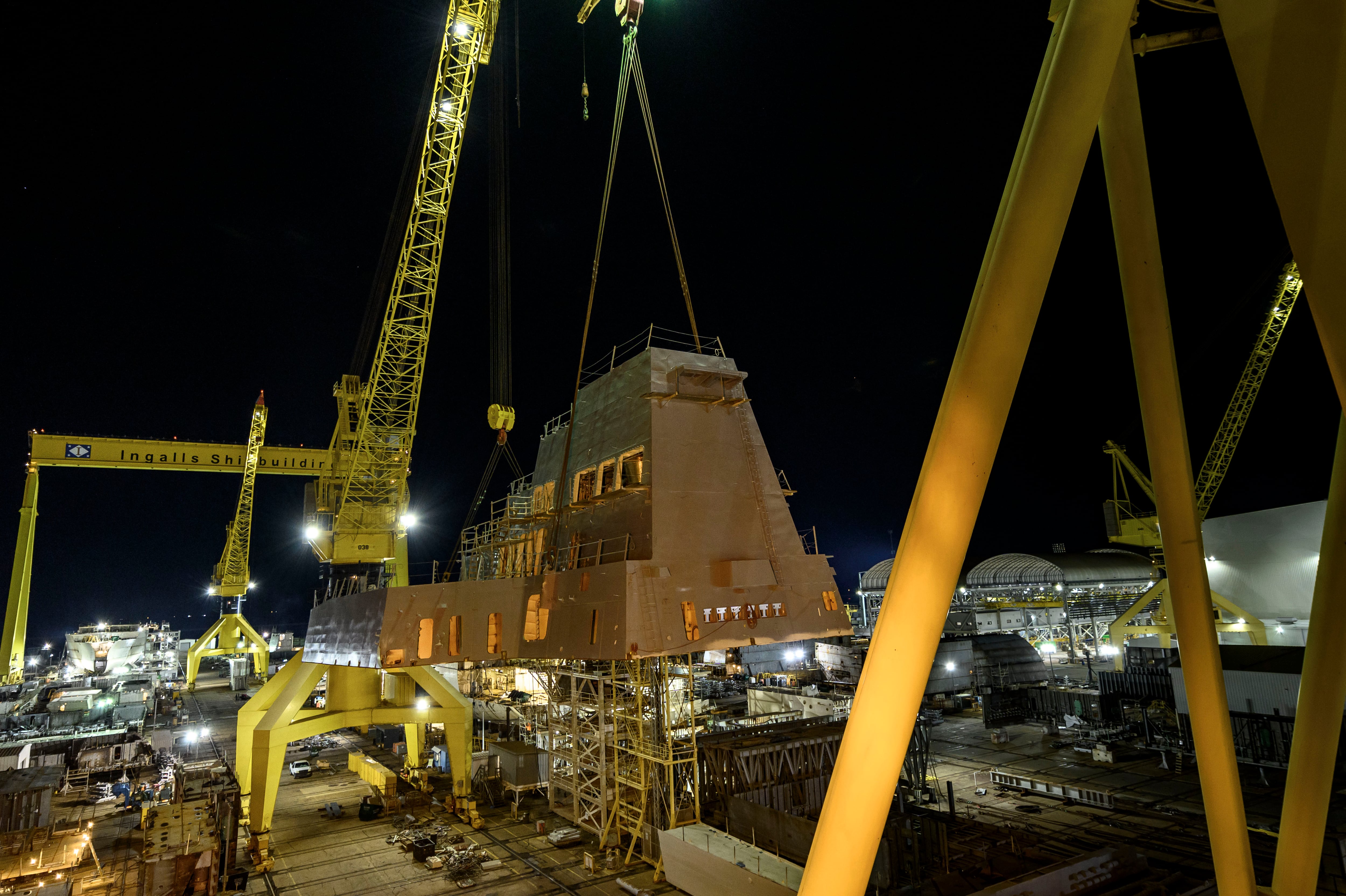WASHINGTON — The U.S. Navy is most interested in buying a second destroyer in fiscal 2022 if it were given money beyond what’s in the White House-approved budget, the service wrote in its annual Unfunded Priorities List.
The Navy’s budget request, released May 28, included eight ships – four warships and four support ships, including just one destroyer. But in a second document, obtained by Defense News on June 1, the Navy told lawmakers that its top need is $1.66 billion to buy a second destroyer in FY22, to meet its obligation under multiyear contracts with both Ingalls Shipbuilding and General Dynamics Bath Iron Works that call for each to build one ship in FY22.
The document notes the Flight III Arleigh Burke-class destroyer “provides increased multi-mission capability and capacity in the most demanding warfight.”
The Flight III destroyer would not only help replace the sea service’s aging cruisers, but its purchase would avoid a $33 million penalty the Navy would pay for breaking its obligation under the multiyear contract and would ensure that the flow of construction at both Ingalls and Bath remains on track.
Rear Adm. John Gumbleton, the Navy’s deputy assistant secretary for budget, said in a May 28 press briefing that the decision to buy just one destroyer “was clearly a hard choice with respect to what we could afford.” The follow-up Unfunded Priorities List makes clear that the Navy really does want the second destroyer in FY22 if the money to pay for it can be found.
The Unfunded Priorities List, which outlines $5.6 billion for 31 items, continues the same themes as the president’s budget request, prioritizing today’s readiness over growing the fleet: 12 items to boost readiness, 11 to build future capability and eight that address the capacity of the fleet.
Strong support exists in Congress for shipbuilding, especially in the House Armed Services Committee, and in recent years lawmakers have consistently added ships into the budget beyond what the Navy asked for as a way to help grow the fleet or to help the industrial base. Lawmakers have already expressed concern over the Navy’s original request for just one destroyer.
The second and third items on the list directly address the future environment where all ships, planes and weapons will operate in a dispersed manner and need to remain netted together even against an adversary that could challenge Navy networks and communications.
The second item on the list asks for $54 million to accelerate the development of the Naval Tactical Grid, or the Navy’s contribution to the Joint All- Domain Command and Control (JADC2).
Third is an $87 million investment in resilient communications and position, navigation and timing (PNT) for the Combat Logistics Fleet. Though warships have been upgraded in recent years to prepare for a fight against Russia or China, many of the logistics ships that would be increasingly important for such an arrangement have not received the same upgrades.
This item would ensure these logistics ships “are capable of communicating and positioning in all environments, to include degraded environments,” by buying and installing four Consolidated Afloat Networks Enterprise Services (CANES) systems for CLF ships, five sets of single channel radios, and 11 commercial satellite systems “to improve security and functionality of CLF communications,” reads the document.
Three of the most expensive items on the list – other than the destroyer – are new aircraft.
The Navy asks for $535 million to buy five more F-35C Joint Strike Fighter aircraft for the fleet, increasing the total buy from 15 to 20 in FY22. This would help the Navy move faster as it transitions to an air wing of the future that includes F/A-18E-F Super Hornets and F-35Cs in equal numbers.
The Navy noted in its document that the increased buy in FY22 would prepare the Navy for peer competition with China or Russia “by increasing USN capacity of the most advanced F-35C in production. Additional Low Rate Initial Production (LOT-16) F-35C aircraft provide advanced capability not currently available in the fleet such as, Sidekick/6-in the Bay, aft heavy weapons (i.e., Advanced Anti-Radiation Guided Missile-Extended Range (AARGM-ER)), and Block-4 TR-3 processors.”
The Navy asked for $334 million to buy four additional CMV-22Bs, the Navy’s version of the V-22 Osprey, which will replace the aging C-2A Greyhound as the carrier onboard delivery platform that brings people, parts and mail to an aircraft carrier at sea.
The document stated that the Navy only has 44 aircraft in its procurement plans, but the additional four would allow the Navy to reach the total warfighting requirement of 48 CMV-22s, which it calls “essential to the resupply of air wing of the future and logistical support of distributed maritime operations.”
Also on the list is $306 million for another two C-130J-30 airplanes.
“This request will start the recapitalization to C-130J aircraft and begin divestment of legacy C-130T aircraft. The C-130 Hercules is the Navy’s only organic intra-theater aerial logistics platform capable of providing oversized cargo capability (including all modules of the F-35 engine) to support forward deployed Naval Forces in Resupply, Rearm, Refuel, and Reconstitute,” the document reads.

Other larger spending items support readiness through ship and aircraft maintenance work and increased flying hours:
- $222 million would repair 86 airframes and 489 engines and engine modules for E-2, E-6B, F/A-18E/F/G, MH-60R/S, and P-8A aircraft, reads the document. As the Navy has done a better job keeping these aircraft in a “mission capable” readiness status, the document adds, the Navy can fly more for training and operations, but then it also has to perform more routine maintenance.
- A $280 million request both adds 37,000 more flying hours for naval aviation and addresses the rising cost of operating aircraft. The request notes that “Naval Aviation is experiencing significant growth in cost, commensurate with the civilian aerospace industry and demand for repairable and consumable parts to sustain operational readiness and improved mission capable rates,” reads the document.
Another $207 million would pay for ship maintenance work that’s expected to take place in early FY23, helping ensure those availabilities start on time regardless of what the FY23 budget process looks like and any delays that may arise. The funding also supports an ongoing drive to get ships into and out of private yard ship maintenance availabilities on time and on budget – an effort that has emphasized the basics like better planning, awarding contracts early, ensuring all materials are on hand when the work starts and more.
To build future lethality, the list includes several items for high-priority weapons fielding and development:
- It asked for $96 million to accelerate the purchase and installation of the Naval Strike Missile to support Littoral Combat Ship deployments, buying eight instead of six of the over-the-horizon weapon systems and paying to install them on four Independence-variant and four Freedom-variant LCSs. It would also add 30 more missiles to the FY22 buy – 64 instead of 34 missiles – to support planned LCS operations.
- The Navy wants $126 million to support its hypersonic conventional prompt strike missile. The funding would pay for a Joint Flight Campaign-3 test event, an Under Water Launch (UWL) Test Facility and the development and integration of advanced capabilities such as “efforts to improve sensor capabilities in Global Positioning System (GPS) denied environments,” reads the document. The Navy and Army are working together on the missile, but the Navy will have to outfit the missile with a launching system that works from both a surface ship like the Zumwalt-class destroyer or a submarine like the Ohio-class guided-missile submarine.
Megan Eckstein is the naval warfare reporter at Defense News. She has covered military news since 2009, with a focus on U.S. Navy and Marine Corps operations, acquisition programs and budgets. She has reported from four geographic fleets and is happiest when she’s filing stories from a ship. Megan is a University of Maryland alumna.




